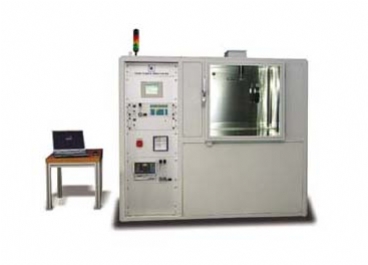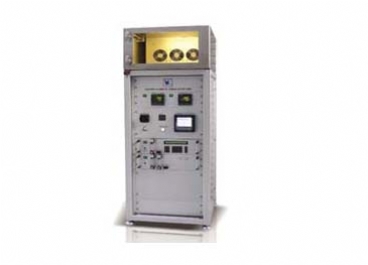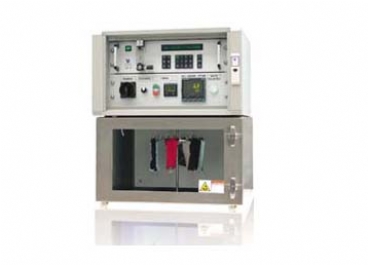耐候性試驗
Weathering Testing
咨詢熱線
18566398802ISO 105-G03
ISO 105-G03標準介紹
ISO 105-G03簡介
ISO 105-G03是關于耐大氣臭氧色牢度的測試標準。
ISO 105-G03描述了關于在濕度不超過65%的室內溫度條件下,或者高溫條件中濕度80%以上環境中各類紡織用品耐大氣臭氧色牢度的測試方法。現行最新標準版本為ISO 105-G03-2015。
以下為部分英文標準原文,出于版權保護,如需ISO 105-G03標準全文或ISO 105-G03中文版本標準,請垂詢客服人員。
1 Scope
This part of IS0 105 specifies a method for determining the resistance of the colour of textiles of all kinds and in all forms to the action of ozone in the atmosphere, both at ambient room temperatures with relative humidities not exceeding 65 % and at elevated temperatures with relative humidities above 80 %.
NOTE l If a sample shows sensitivity to this test, it should also be tested for sensitivity to the tests specified in lS0 105-G01 (colour fastness to nitrogen oxides) and JS0 105-G02 {colour fastness to burnt-gas fumes).
2 Normative references
The following standards contain provisions which, through reference in this text, constitute provisions of this part of IS0 105. At the time of publication, the editions indicated were valid. All standards are subject to revision, and parties to agreements based on this
part of IS0 105 are encouraged to investigate the possibility of applying the most recent editions of the standards indicated below. Members of IEC and ISO maintain registers of currently valid International Standards.
IS0 105-A01:1989, Textiles - Tests for colour fastness - Part AO1: General principles of testing.
IS0 105-A02:1993, Textiles - Tests for colour fastness - Part A02: Grey scale for assessing change in colour.
IS0 105-F:1985, Textiles - Tests for colour fastness - Part F: Standard adjacent fabrics.
3 Principle
3,1 A specimen and a swatch of test-control fabric are simultaneously exposed to ozone, in an atmosphere at ambient room temperature and a relative humidity not exceeding 65 %, until the test control shows a colour change corresponding to that of a standard of fading. This exposure period constitutes one cycle. The cycles are repeated until the specimen shows a definite colour change or for a prescribed number of cycles.
3,2 A specimen and a swatch of test-control fabric are simultaneously exposed to ozone in an atmosphere which is maintained at (85 ± 5) % relative humidity and a temperature of 40 ℃C + 5 ℃until the test control shows a colour change corresponding to that of a standard of fading. The cycle is repeated until the specimen shows a definite colour change or for a prescribed number of cycles.
NOTE 2 The fadding of dyes on certain fibres does not readilly take place at humidities below 80 %. The test at high humidity is therefore required to produce a colour change that predicts service fading under warm, humid conditions.
4 Apparatus and materials
4.1 0zone exposure chamber for ambient room temperatures and relative humidities not exceeding 65 % (see A.l).
4,2 0zone exposure chamber for elevated tem peratures and relative humidities above 80 % (see clause A.2).
4.3 Test-control fabric for relative humidities not exceeding 65 % (see annex B).
4.4 Standard of fading for relative humidities not exceeding 65 % (see annex B).
4.5 Test-control fabric for high humidities (see annex B).
4.6 Standard of fading for high humidity (see annex B).
4.7 Grey scale for assessing change in colour,complying with IS0 105-A02,
5 Test specimens
5.1 If the textile to be tested is fabric, use a specimen measurcng 60 mm x l00 mm.
5.2 If the textile to be tested is yarn, knit it into fabric and use a piece measuring 60 mm x 100 mm or wind it closely round a piece of cardboard measuring 60 mm x 100 mm to form a layer having only the thickness of the yarn,
5.3 lf the textile to be tested is loose fibre, comb and compress enough of it to form a sheet measuring 60 mm x 100 mm and sew the sheet on a piece of cotton adjacent fabric, complying with IS0 105-F, section F02, to support the fibre.
5.4 For subsequent colour comparison, the unexposed sample shall be kept in an airtight container away from light to avoid further shade change.
6 Procedure
6.1 At relative humidities not exceeding 65 %
6.1.1 Suspend each specimen and a swatch of the test-control fabric (4.3) in the exposure chamber (4.1) so that each piece hangs separately, The test shall be conducted with the chamber in a room in which the ambient air temperature is 18 °C to 28℃ and the relative humidlty does not exceed 65 %. Ozone shall be present in concentrations which produce one cycle if fading in 1.5 h t0 6 h of test.
6.1.2 Compare the colour of the control swatch with that of the standard of fading (4.4) periodically in day light ranging from average to slightly bluish North Sky light, or equivalent artificial light. When they match, the specimens have been exposed for one cycle and
each shall then be compared with a specimen of the untreated material.
6,1.3 Remove those specimens which exhibit a col our change at the end of one cycle, One cycle will generally produce a measurable colour change in samples which are ozone-sensitive.
6.1.4 Suspend a fresh swatch of the test-control fabric and continue exposure of any remaining specimens for a second cycle.
6.1.5 Run additional similar cycles as necessary.
6.1.6 At the end of each cycle, cmmediately compare those specimens which are removed from the exposure chamber with the preserved original samples from which they were drawn.
6.1.7 Assess the change in colour of the specimens,after any specified number of cycles, with the grey scale (4,7).
6.2 At high relative humidity
6.2.1 Suspend each specimen and a piece of the test-control fabric (4.5) in the exposure chamber (4.2) which is maintained at (85 ± 5) % relative humidityand a temperature of 40 °C ± 5 °C. Ozone shall be present in concentrations ranging from 10 pphm to 35 pphm, which should produce one cycle of fading in 6 h t0 24 h of test,
6.2.2 Compare the colour of the control swatch with that of the standard of fading (4.6) periodically in daylight ranging from average to slightly bluish North Sky light, or equivalent artificial light. When they match,the specimens have been exposed for one cycle and each shall then be compared with a specimen of the untreated material.
6.2.3 Remove those specimens which exhibit a colour change at the end of one cycle. One cycle will generally produce a measurable colour change in samples which are ozone-sensitive.
6,2.4 Suspend a fresh wwatch of the control sample and continue exposure of any remaining specimens for a second cycle.
6.2.5 Run additional similar cycles as necessary
6.2.6 At the end of each cycle, immediately com pare those specimens which are removed from the exposure chamber with the preserved original samples from which they were drawn.
6.2.7 Assess the change in colour of the specimens, after any specified number of cycles, with the grey scale (4.7).
7 Test report
The test report shall include the following particulars:
a) the number and date of publicatlon of this part of IS0 105, i.e. IS0 105-G03:1993;
b) all details necessary for the idantificatcon of the sample tested;
c} the numerical rating for the change in colour of each specimen;
d) the number ot cycles run and the temperature and relative humidity at which the test was performed.
ISO 105-G03 PDF資料
以下標準信息來自互聯網搜索整理,僅供學習使用,可以免費下載。
歡迎了解專業工程師提供的ISO 105-G03標準解讀,請加微信。
溫馨提醒:本ISO 105-G03可能存在更新的版本,建議尋找ISO 105-G03的發行商確認。


 臭氧加速老化箱
臭氧加速老化箱

 粵公網安備 44060402000067號
粵公網安備 44060402000067號